There is, in fact, a lot of sneaking and stabbing. The sixth book is more of a spy novel than a military novel. Although it begins and ends with grand ship battles, most of the plot unfolds in the streets and halls of Boston. Both Aubrey and Maturin are cornered, the former trapped in, all of all places, an asylum, and the later on the run from French agents and a villainous American who is also the man who stole way Maturin's beloved Diana Villiers. O'Brian does a pretty respectable job walking the path of Fleming and Ludlum. If this was a Bond, it would be On Her Majesty's Secret Service, in which the spy does not have the upper hand, and the love is potentially fatal. Which also happens to be my favorite Bond.
After half a a dozen Aubrey-Maturin books, I am really impressed on how O'Brian can stay true to genre but create whole new settings for each book. The Fortune of War is a direct continuation of the story arc started in Desolation Island. It is also follows the unfolding of history. Best of all, it deepens the characters of the Captain and the Doctor. Bravo...again.
 |
| 17th century map of the Spice Islands |
(1) HMS Leopard, after its near destruction in the south Indian Ocean, limps into Pulo Batang in the Malay Archipelago. Capt. Jack Aubrey recounts the adventure to Drury, the Port Admiral. Horrible old Leopard is doomed to transport duty. Aubrey and his friend Dr. Stephen Maturin are given orders to sail home aboard the La Fléche, due from Bombay. Aubrey stands up for his officers and midshipmen, insisting they be sent back to Britain as well. Maturin meets with Wallis, the Admiral's political advisor, and learns that his friend Sir Joseph is, thankfully, back in charge of British intelligence. Furthermore, the poisoned dispatches Maturin had planted with the American spy, Louisa Wogan, have in fact reached their destinations and made tremendous confusion in the French services. Maturin must make haste back to Catalonia and renew his activities. Meanwhile, the English disruption of American trade and their abduction of American seamen have driven the two countries to almost inevitable war. Aubrey learns that once home he is to be given command of the heavy, 40-gun Acasta. As the Leopards wait for La Fléche, they engage in a game of cricket with the local men. Maturin's experience in Irish hurling makes for an interesting contest.









